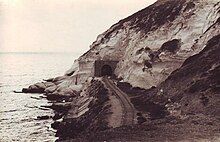Coastal railway line, Israel
The Coastal railway line is a mainline railway in Israel, which begins just south of the Lebanon-Israel border on the Mediterranean coast, near the town of Nahariya in Northern Israel and stretches almost the entire Mediterranean coast of the country, to just north of the border with the Gaza Strip in the south.
History

The northern part of the coastal line from Acre (Akko) to Remez Junction (located south of today's Caesarea-Pardes Hanna Railway Station) was built by the British during the 1920s and operated by Palestine Railways. In 1941–42 engineers of the South African Army and New Zealand Army extended the line north to Beirut and Tripoli, Lebanon through railway tunnels at Rosh HaNikra grottoes. Following the 1948 Arab–Israeli War the tunnel linking the line to Lebanon was blocked.
The section south from Remez junction including its then-terminus, the Tel Aviv Central Railway Station, were built by Israel Railways in the beginning of the 1950s and the new line opened in May 1953 with Tel Aviv Central opening in November 1954. This new railroad then became the main north-south rail link between northern and central Israel, supplementing the older, more easterly/inland section which connected Remez junction and the nearby Hadera East Railway Station to the Lod Railway Station in central Israel that was constructed during the Ottoman period (and known today as the Eastern railway line, which has been partially abandoned since 1969). This new section of coastal railway from Remez junction linked the Tel Aviv Central Station and Haifa Central Railway Station and significantly shortened the travel time between the two cities as well as providing rail service to the cities of Herzliya and Netanya.
Little development of the line followed for the next forty years until the early 1990s when it was extended southwards from Tel Aviv Central through the heart of the Tel Aviv region along the Ayalon Highway, and connected with the Jaffa–Jerusalem railway. The opening of this railway section heralded a new era of railway development in the country as it allowed trains from the north to reach the south of the country through, rather than around the nation's largest metropolis. This particular section of the Coastal Railway through Tel Aviv consists of triple or quadruple track and is commonly referred to as the Ayalon Railway and nowadays serves as the hub of the national railway network, with many train lines operating on this railway section.
Over the years additional stations were built along the line, including: Tel Aviv HaHagana, Tel Aviv HaShalom, Tel Aviv University, Hadera West Railway Station, Caesarea-Pardes Hanna Railway Station, Haifa Hof HaCarmel, Hutzot HaMifratz Railway Station and Lev HaMifratz Railway Station.
A new section that includes six new stations along the South Ayalon Highway and Highway 4 was constructed in the early 2000s and connected the Coastal Railway with the Ashdod Railway Station (which is technically located on the Lod–Ashkelon railway). The first phase of this work involved extending the coastal railway from the HaHagana Railway Station to the new Rishon LeZion Moshe Dayan Railway Station, serving the southern Tel Aviv area suburbs and opening for service in September 2011. The remainder of the route to Ashdod opened in 2013, with the intermediate Yavne West Railway Station having opened in early 2012. This last section features a long cut-and-cover tunnel south of Yavne and a large flying junction at the intersection of the new coastal railway with the Lod–Ashkelon railway and the railway branch to the Port of Ashdod. From Ashdod, the existing railway from Lod extends south along the coast to near Yad Mordechai through Ashkelon (with a connection to the Heletz railway). From Yad Mordechai a new railway completed in 2015 branches inland to the southeast, connecting to Beersheva through the northern Negev.
Beginning in the late 1980s, works started to double track the line in stages. These were finished in 2013 when double tracking works on the railway section between Akko and Nahariya were completed. Nowadays the line consists of at least double track throughout its entire length.
Services

Both intercity and suburban services operate on the line. The intercity service from Nahariya and Haifa to Tel Aviv and suburban services in both the Tel Aviv metropolitan area and the Haifa metropolitan area. Freight trains operate on the line as well.
The line is the busiest on the Israel Railways network, with the section along the Ayalon Highway the busiest on the line.
Plans
Currently in the planning and permitting stages are works to electrify the line, though the Haifa municipality strongly opposes the electrification plan for aesthetic and public access reasons since the railway lies so close to the coastline within its borders. Work on the Ayalon section, the first part of the railway to be electrified is expected to begin around 2017.
Because the line is Israel's most congested, there are plans to add two additional tracks to it in stages between Tel Aviv and Binyamina. Currently the section between Tel Aviv Central and Tel Aviv University stations consists of four tracks, with works to extend the four track section to Herzlia expected to be completed in 2017. Also planned is the rebuilding of the old Eastern line to act as a backup railroad to the coastal line south of Remez junction, while at other times to serve mainly freight trains with some limited passenger service.
